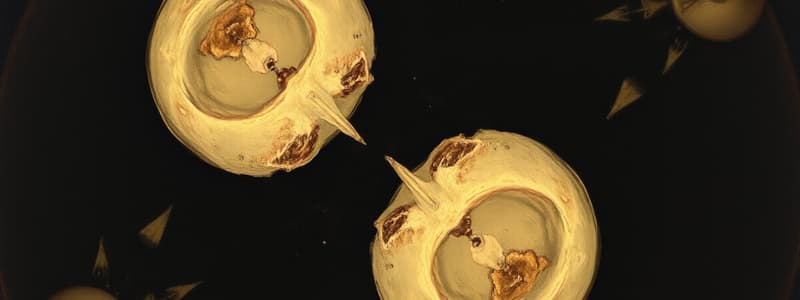Podcast
Questions and Answers
How does independent assortment contribute to genetic variability during meiosis?
How does independent assortment contribute to genetic variability during meiosis?
- By allowing chromosomes from both parents to sort into any gamete. (correct)
- By eliminating genetic information from the daughter cells.
- By pairing only homologous chromosomes together.
- By ensuring all chromosomes are inherited from the mother.
During which phase of meiosis do tetrads form and crossing over occur?
During which phase of meiosis do tetrads form and crossing over occur?
- Metaphase I
- Telophase II
- Anaphase II
- Prophase I (correct)
What happens to the chromosome number of the daughter cells at the end of meiosis I?
What happens to the chromosome number of the daughter cells at the end of meiosis I?
- It is tripled from the parent cell.
- It is halved compared to the parent cell. (correct)
- It is doubled from the parent cell.
- It remains unchanged from the parent cell.
Which stage involves the alignment of chromosomes along the cell's middle during meiosis II?
Which stage involves the alignment of chromosomes along the cell's middle during meiosis II?
What is the result of cytokinesis following meiosis II?
What is the result of cytokinesis following meiosis II?
What is the primary purpose of the cell cycle?
What is the primary purpose of the cell cycle?
During which phase of the cell cycle does DNA replication occur?
During which phase of the cell cycle does DNA replication occur?
What happens during the G1 Phase of the cell cycle?
What happens during the G1 Phase of the cell cycle?
What characterizes the G0 Phase of the cell cycle?
What characterizes the G0 Phase of the cell cycle?
What occurs at the end of the M Phase?
What occurs at the end of the M Phase?
What is the significance of chromatids during the cell cycle?
What is the significance of chromatids during the cell cycle?
Which phase is the longest in the cell cycle?
Which phase is the longest in the cell cycle?
During which phase does the cell prepare for mitosis?
During which phase does the cell prepare for mitosis?
What is the main function of the mitotic spindle during mitosis?
What is the main function of the mitotic spindle during mitosis?
During which phase of mitosis does the nuclear envelope begin to break down?
During which phase of mitosis does the nuclear envelope begin to break down?
What is the role of the centromere in a chromosome?
What is the role of the centromere in a chromosome?
What characterizes anaphase in the cell cycle?
What characterizes anaphase in the cell cycle?
Which of the following statements accurately describes telophase?
Which of the following statements accurately describes telophase?
What distinguishes meiosis from mitosis?
What distinguishes meiosis from mitosis?
During which phase are chromosomes most visible under a light microscope?
During which phase are chromosomes most visible under a light microscope?
What occurs at the cleavage furrow during the cell cycle?
What occurs at the cleavage furrow during the cell cycle?
Flashcards are hidden until you start studying
Study Notes
Cell Cycle Overview
- The cell cycle allows organisms to reproduce in a controlled manner, facilitating growth and maintenance of life.
- All cells possess the capability to divide and reproduce.
Cell Division
- A crucial component of the cell cycle.
Mitosis
- Vital for active eukaryotic cells, mitosis occurs in distinct phases to produce new cells.
- M phase is the observable stage under a microscope where chromosomes and nuclei are visible.
- M Phase duration is relatively brief compared to the longer interphase.
Interphase
- DNA exists as chromatin instead of distinct chromosomes.
- Interphase is divided into three main phases: G1, S, and G2.
G1 Phase (Gap 1)
- Acts as a decision-making step where the cell assesses whether to progress in the cycle, rest, or enter G0 phase.
G0 Phase
- Known as the resting phase where cells maintain functions without division or preparation for division.
S Phase (Synthesis)
- Site for DNA replication, resulting in a doubling of DNA content as the nucleus enlarges.
G2 Phase (Gap 2)
- Represents final growth and preparation phase before mitosis begins.
Cytokinesis
- The physical process of dividing the cytoplasm, resulting in two separate daughter cells.
- Initially, a eukaryotic cell is diploid (2n); during S phase, DNA content doubles but consists of chromatids, not separate chromosomes.
Mitosis Phases
Prophase
- Chromatin condenses into recognizable chromosomes consisting of sister chromatids connected at a centromere.
- Formation of the mitotic spindle begins, originating from centrosomes.
Prometaphase
- Transition where the nuclear envelope breaks down, allowing spindle fibers to interact with chromosomes.
Metaphase
- Chromosomes align centrally with one sister chromatid connected to each centrosome.
Anaphase
- Sister chromatids separate and move toward opposite poles of the cell as the spindle elongates.
Telophase
- Chromosomes decondense and a new nuclear envelope forms; marks the conclusion of cytokinesis where two identical daughter cells emerge.
Importance of Cell Cycle
- Essential for the growth and sustainability of multicellular organisms.
Meiosis Overview
- A specialized cell division process for gametes, involving two sets of divisions: meiosis I and meiosis II.
Differences Between Mitosis and Meiosis
- Mitosis results in genetically identical cells while meiosis allows genetic material exchange between homologous chromosomes during prophase I.
- Independent assortment in meiosis enhances genetic variability in daughter cells.
- Alleles of the same gene segregate independently during meiosis.
Meiosis Phases
Prophase I
- Formation of tetrads (XX) through pairing of homologous chromosomes, facilitating crossing over.
Metaphase I
- Tetrads align at the metaphase plate; independent assortment occurs.
Anaphase I
- Homologous chromosomes move to opposite ends of the cell.
Telophase I
- Each nucleus contains a reduced number of chromosomes.
Cytokinesis I
- Divides the cell membrane to form two haploid (n) daughter cells with half the chromosome number.
Prophase II
- Each of the two daughter cells contains chromosomes made of sister chromatids.
Metaphase II
- Chromosomes align at the center of each daughter cell.
Anaphase II
- Sister chromatids separate and move to opposite sides of the cell.
Telophase II
- Results in four nuclei, each with two single chromatids.
Cytokinesis II
- Finalizes with the division of the cell membrane, producing four haploid daughter cells.
Studying That Suits You
Use AI to generate personalized quizzes and flashcards to suit your learning preferences.




